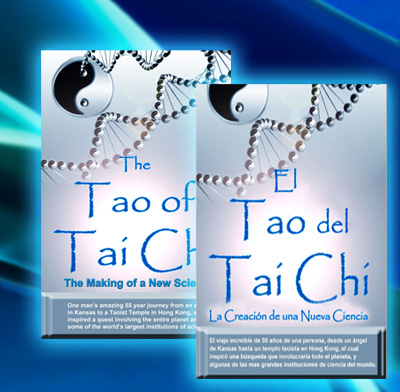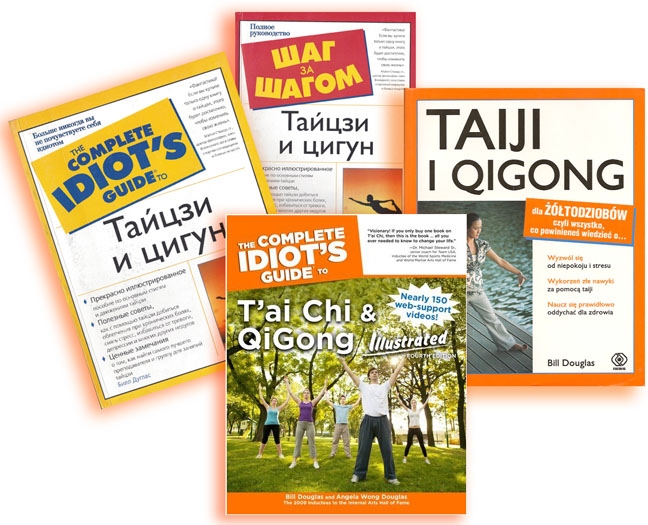BACK PAIN and Tai Chi &
qigong
SCROLL DOWN FOR YOGA, QIGONG, MINDFULNESS, MEDITATION
BACK PAIN and TAI CHI!
Prevention Magazine reported a study
where, after one year of Tai Chi classes, a group of men and
women ages 58 to 70 found increased strength and increased
flexibility in their back, helping to reduce the odds of back
pain.
NIH (National Institutes of Health)
Tai chi exercise for treatment of pain and disability in
people with persistent low back pain: a randomized controlled
trial.
CONCLUSION: This is the first pragmatic
randomized controlled trial of tai chi exercise for people
with low back pain. It showed that a 10-week tai chi program
improved pain and disability outcomes and can be considered a
safe and effective intervention for those experiencing
long-term low back pain symptoms.
http://www.ncbi.nlm.nih.gov/pubmed/22034119
Tai
Chi Shown to Ease Back Pain
Research shows that tai chi can
be effective for managing the persistent low-back pain that
many people experience.
-- Arthritis Today, January, 2012
Results found that the majority of these articles
showed movement-based mind-body interventions to be
effective for treatment of low back pain, reporting
positive outcomes such as reduction in pain or psychological
distress such as depression and anxiety, reduction in
pain-related disability, and improved functional ability.
Among the key findings, researchers discovered that longer
duration and high-dose yoga intervention showed reductions in
back pain while tai chi reduced acute lower back pain in males
in their 20s. Tai chi also was more effective than stretching
for lower back pain in young males. In the general community,
tai chi showed greater reductions in pain intensity,
bothersomeness of pain symptoms, and pain-related disability
than the control intervention. Because there are only three
qigong studies to date, it was unclear to the researchers
whether this intervention is useful in treating chronic lower
back pain. Existing research suggests positive benefits of
yoga, however, tai chi and qigong for lower back pain are
still under-investigated.
-- SCIENCE DAILY, Feb. 6, 2020
Most alternative treatments have either not
been scientifically tested or subjected to limited
investigations, says Arthritis Research UK.
Of 25
therapies, only a handful were judged to have enough medical
evidence to support their use.
These included acupuncture,
massage, tai chi and yoga ...
For sore backs, yoga and
acupuncture appeared the most effective, and there was some
evidence to also support the use of osteopathy and relaxation
therapy as well as the Alexander technique which focuses on
posture and movement.
Lower back pain was the most
investigated condition, with 75 trials of 14 different
therapies across over 11,600 participants.
According to the
lead author of the report, Dr Gareth Jones from the University
of Aberdeen, there is very little evidence for most
complementary therapies ...
"But there are some
exceptions, like acupuncture and the whole body therapies like
massage and tai chi, which do appear to work."
-- BBC News
Online, Health Editor, Jan. 8, 2013
ScienceDaily (June 17, 2009) — A new
study by The George Institute for International Health has
found Tai Chi to have positive health benefits for
musculoskeletal pain. The results of the first comprehensive
analysis of Tai Chi suggest that it produces positive effects
for improving pain and disability among arthritis sufferers.
The researchers are now embarking on a new trial to
establish if similar benefits can be seen among people with
chronic low back pain.
BACK PAIN &
T'AI CHI HEALTH ARTICLES:
1. Atchison, J.W., Taub,
N.S., Cotter, A.C., & Tellis, A. (1999). Complementary and
alternative medicine treatments for low back pain. Physical
Medicine & Rehabilitation: State of the Art Reviews,
13(3):561-86, 1999 Oct, 13(120 ref), 561-586.
2.
Bankhead, C. (1998). T'ai chi helps lower BP in elderly,
showing benefit of light physical activity. Medical Tribune,
39(8):10, 1998 Apr 16, 39(8), 10
3. Koh, T.C. (1982).
Tai Chi and ankylosing spondylitis--a personal experience. Am
J Chin Med JID - 7901431, 10(1-4), 59-61.
4. Abenhaim,
L., Rossignol, M., Valat, J., Nordin, M., Avouac, B., Blotman,
F., Charlot, J., Dreiser, R.L., Legrand, E., Rozenberg, S., &
Vautravers, P. (2000). The role of activity in the therapeutic
management of back pain: report of the International Paris
Task Force on Back Pain. Spine, 25(4S Suppl):1S-33S, 2000 Feb
15, 25(119 ref), 1S-33S.
FIND MUCH MORE RESEARCH AT THE "QIGONG INSTITUTE DATABASE"
Since 1984, collecting breaking medical/science research on
Qigong, Tai Chi, Yoga, and Mind-Body Education
Click here
for Qigong Institute Database...
YOGA RESEARCH ON BACK PAIN ...
.Yoga
helps relieve chronic back pain
Yoga can help
people with arthritis, fibromyalgia,
migraine, low back pain, and many other types
of chronic pain conditions. A study published
in Annals of Internal Medicine found that among 313 people
with chronic low back pain, a weekly yoga class increased
mobility more than standard medical care for the condition.
Another study published at nearly the same time found that
yoga was comparable to standard exercise therapy in relieving
chronic low back pain.
A meta-analysis of 17 studies
that included more than 1,600 participants concluded that yoga
can improve daily function among people with fibromyalgia
osteoporosis-related curvature of the spine. Practicing yoga
also improved mood and psychosocial well-being.
-- HARVARD HEALTH PUBLISHING
* NOTE: World Tai Chi & Qigong Day advises
consulting your physician before beginning any new exercise,
herbal, diet, or health program. The research listed here is
meant to stimulate a discussion between you and your
physician, health insurance carrier, etc., not as medical
advise. Research and comments provided here are hoped to
stimulate a more robust discussion of powerful natural
mind/body health tools. Popular media, health media, and
government must increase attention to stunning emerging
research, including the UCLA study indicating Tai Chi
participants enjoyed a 50% increase in immune system
resistance to viral infection.
- To learn more about tai chi & qigong medical research,
see the below book,
"the complete idiot's guide to tai chi & qigong,", and also
"Harvard Medical School Guide to Tai Chi," and
"The way of qigong: the art and science of chinese energy healing."
Click to purchase this acclaimed best-selling Tai Chi book, with nearly 150 web-video support videos for the detailed text/illustration instruction as a "gift of health" for loved ones.
A new paradigm in multi-media educational books.
"Visionary! If you only buy one book on T'ai Chi, then this
is the book. This book is all you ever needed to know to
change your life. I have taught T'ai Chi for several decades
myself, yet I have now read Bill's book from cover to cover
seven times, and still get something new from it each time."
– Dr. Michael Steward Sr., D.MA, Ph.D., MA, Senior
Coach for Team USA, Inductee of the World Sports Medicine and
World Martial Arts Hall of Fame
"Sometimes Chinese
culture can be difficult to explain. Sifu Bill Douglas
successfully uses American culture to explain the art of T'ai
Chi Chuan. He simplifies difficult concepts, making them
easier to understand. This book takes the best parts of T'ai
Chi and makes them understandable [to Westerners] without
requiring a grounding in Chinese culture and history."
– Sifu Yijiao Hong, USA All-Tai Chi Grand Champion and USA
Team member; Certified International Coach and Judge,
International Wushu Federation
"Douglas has
achieved for QiGong what Apple did for the computer. He's
brought it to the people … great place to start for beginners.
… Teachers may also find this an excellent manual 'on how to
explain these concepts to the general public…'"
– R.
Poccia,
"The Tao of Tai Chi: The Making of a New Science" (now available in both English and Spanish))

Harvard's Dr. Peter Wayne discusses Tai Chi, Qigong and Bio-Energy with Neuro-biologist, Dr. Richard Hammerschlag,
with WORLD TAI CHI & QIGONG DAY ONLINE SUMMIT HOSTS
World Tai Chi & Qigong Day's series of Official ONLINE
SUMMITS, have brought some of the top minds in Tai Chi, Qigong,
and cutting edge scientists researching Mind-Body practices.
World Tai Chi & Qigong Day's global health education work was
recognized on page 25 of "The Harvard Medical School Guide to
Tai Chi" ...
A reflection of how successful the invasion
has been is World Tai Chi Day, organized by Bill Douglas. One of
the purposes of this day is ‘to bring together people across
racial, economic, religious, and geo-political boundaries, to
join together for the purpose of health and healing, providing
an example to the world.' Millions of people around the world –
65 nations participated in 2011 – gather one day each year to
celebrate the health and healing benefits of Tai Chi and Qigong.
— The Harvard Medical School Guide to Tai Chi (page 25)
Harvard Medical School Researchers Launch 'Tai Chi as Therapy' Lecture to Commemorate World Tai Chi Day
The new Harvard Medical School Guide to Tai Chi is a powerful
reference book for all tai chi and qigong advocates, teachers,
etc. The Harvard Guide cites WorldTaiChiDay.org's work in
expanding global awareness of tai chi and qigong!
Our
efforts have exposed over ONE BILLION potential viewers/readers
of mass media to Tai Chi and Qigong and its myriad health
benefits, via our annual WTCQD worldwide events.
